
So, we have already dealt with the principles of air exchange in the house, air inflow, overflows, exhaust and kitchen ventilation features. Now let's talk about devices that allow to organize air exchange in conditions when normal operation of the natural ventilation system is impossible to establish. And not just about devices that allow organizing a separate flow of cold and separate removal of warm, but already “used” air. And about smart ventilators who do both at once and both. And at the same time, they are also equipped with an economical device for heating the incoming air due to the heat of the waste - a heat recuperator. This is the very device that will greatly save on heating. For example, a ventilation system with 98% (!) Heat recovery is installed in the Berlin eco-house in the photo below. There is something to fight for!
It's simple, but ... not easy
Powerful and bulky devices of the centralized forced ventilation system (that is, it is usually equipped with an additional recovery function), usually installed in utility rooms or in attics. And then from them and they have to pull intake and exhaust air ducts, moving them around the premises inside the walls or floors. That is why it is better to install them at the construction stage or during a major overhaul of a building - in an already finished house such an operation threatens with a complete rework.
Devices of the decentralized ventilation system, which will be discussed in this article, are very compact (even equipped with a recuperator). And they are no more difficult to install than the inlet valves that we already cut into the wall. This explains not only the increased demand for them, but also a huge number of offers on the market.
Important: One device works only in the room where it is installed - it will not have a significant effect on the ventilation of the house or apartment as a whole. In an apartment where the natural ventilation system does not work, it is easy to cut such an appliance into the wall of the bedroom (and sleep with fresh air and warm). But in the rest of the premises, as before, there will be nothing to breathe. The way out is the installation of several devices that allow you to create exactly the ventilation system, where all devices are under the “single beginning” and work smoothly.
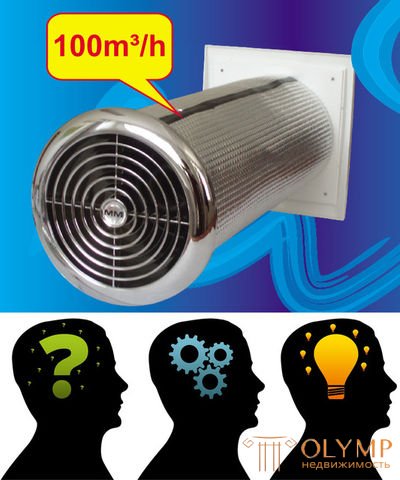
How to use the information
Devices of a decentralized ventilation system offer domestic and foreign brands. The price is attractive and, remarkably, does not depend on the country of production - from 15 to 30 thousand rubles. (although they come across much more expensive).
The devices have slightly different designs, different dimensions and performance, and in addition, different sets of functions, places and methods of installation. We picked up several of these devices on the principle “from simple to complex” so that you can make a preliminary choice. Be sure to check with the norms of air exchange, which we cited in the first article of the cycle.

Ventilation devices UVRK-50 ("Ecoterm")
The device UVRK (Installation Ventilating Recuperative Compact Channel) looks like wall ventilators - it is a piece of pipe with a diameter of 20x40 cm (inside - all the "stuffing") with two tips.
The difference from the conventional ventilator is that the UVRK-50 not only delivers fresh, and heated air into the house, but also removes the waste air. The power consumption of the device does not exceed 19 W (220 V), since the installation receives some of the energy for heating the incoming air due to heat recovery from the exhaust air.
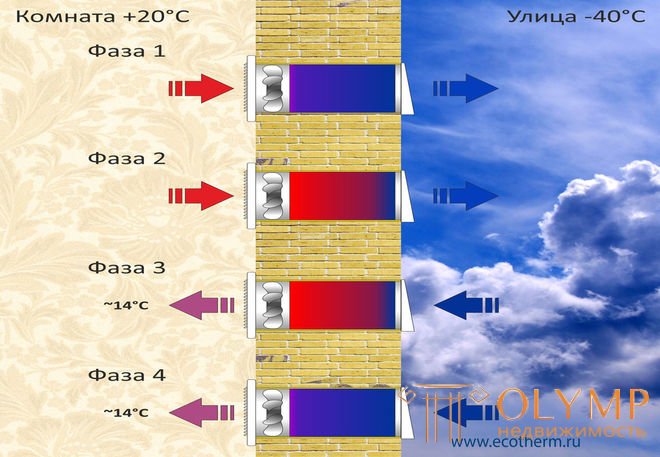
The device works in a very original way - “inhale-exhale”: it resembles a person’s breathing through a scarf during a hard frost — as it exhales, the air heats up the scarf, and the next portion of inhaled air, passing through the scarf fabric, is heated up by itself. In the device itself, this happens as follows: the fan on the "exhalation" emits room air outside, and the latter gives off heat and moisture to the heat exchanger - the regenerator - on the way. After a certain time (about 1 min.), The controller switches the reversible motor with a fan to “inhale”, and air begins to flow from the street into the house. At the same time, passing through the filter and the recuperator-regenerator, it is cleaned, heated and moistened. The noise level of the device is no more than 40 dBA. Productivity is 13-80 cubic meters / h - this is enough for ventilation of a room up to 25-30 sq. M. In larger rooms or with a large number of people, the manufacturer suggests placing several devices, but debugging their modes so that two devices work in antiphase - this increases the ventilation efficiency.
The device can operate in three modes:
Currently, UVRK devices are offered in three versions: UVRK-50M, UVRK-50MA and UVRK-50MK. We will discuss the last two models.
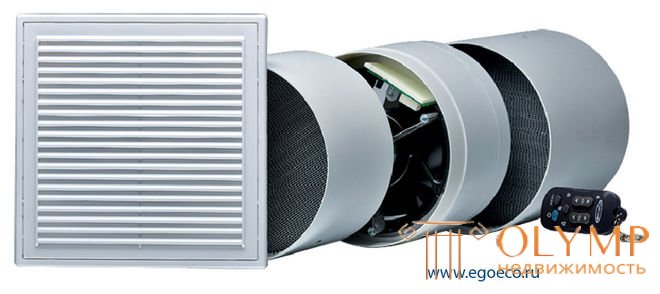
UVRK-50MA differs from its predecessor in that the control unit is transferred to the device itself (this eliminated the need to make a wall specifically for mounting the control unit). To control the device, there is an on / off button on the case of the ventilation unit, and all the operating parameters are changed using the remote control. Also, the device has the following features: synchronization of work with a kitchen hood, centralized on / off and control using sensors of humidity or carbon dioxide, as well as automatic shutdown of the device when a fire alarm is triggered.
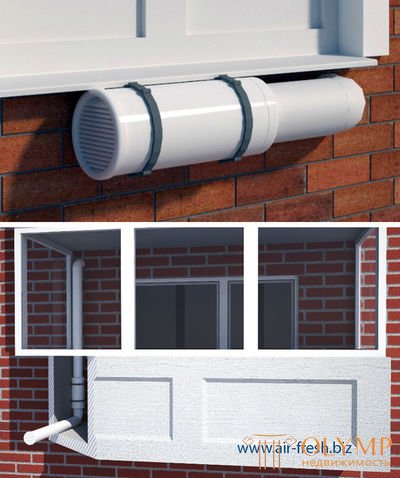
The channel heat exchanger UVRK-50MK has the same characteristics, but differs from the UVRK-50MA in that it is designed to be placed on the external wall from the street or on the loggia (balcony), so that when the device is mounted, the large-diameter hole in the wall is no longer required. In addition, the model has 7 performance levels, switchable from the remote control. However, these devices have an “external” location and a disadvantage: in certain cases, the air ducts and the devices themselves must be protected from heat insulation (preferably foil) from the heat and cold, which will certainly affect their visual appeal.

Accommodation of UVRK-50 ventilators in a two-room apartment
Placing two devices in neighboring residential premises will allow the use of three “ventilation” schemes. In the first case, each fan will air only the room in which it is installed. The second option - the fans will work at the same time, but in antiphase: if one is working on the “inhale”, then the second one at that time makes an “exhale”. And the third option: one device is constantly on the inflow, the second - on the hood (although in this case there will be no heat recovery). But in any of the options, part of the incoming air through the overflow system should be discharged into the exhaust ducts located in the kitchen and bathroom. Otherwise, these premises will simply “suffocate”.

The principle of “breathing” is also used in the Aspira Italian heat exchanger (model AP19980 is the master device and AP19979 is the slave device). It is equipped with a ceramic heat exchanger (it accumulates heat during “exhalation” and gives off during “inhalation”), due to which the recovery efficiency exceeds 90%. The device fan is powered by 12 V and can be configured for 2 performance modes: 25 or 50 cubic meters / h. The wired control unit can simultaneously monitor up to four air handling units operating in combined mode.
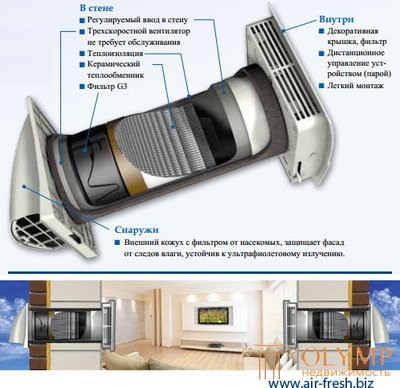
In this respect, the possibilities of organizing a home ventilation system and devices MARLEY MEnV 180 (Germany) are very curious. The manufacturer recommends installing them in pairs: while one device provides fresh air, the other takes warm used air to the outside, accumulating its thermal energy in a ceramic recuperator. After 70 seconds, the fans change the flow direction. Both devices communicate with each other by radio. The use of two synchronously operating heat exchangers is recommended for ventilation of large residential premises, offices and even pre-school and medical institutions.
Of course, there are other devices on the market that use the principle of "breathing": recuperators "TwinFresh" (VENTS company, Ukraine - models RA-50, CA-60 and Comfo RA-25), Ventoxx RV-30 (Ventoxx company, founded in Kharkov by the Swiss founders), ThermoBarrier R-230 (“Zilant Group of Companies, the device has a capacity of 40 to 180 cubic meters / h) and others.
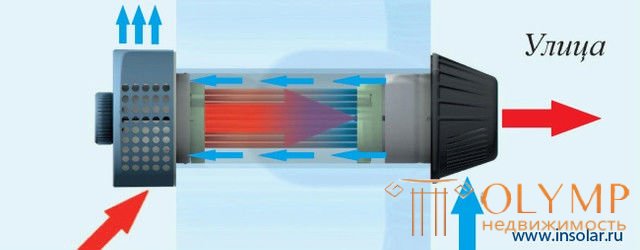
There are devices on the market that use a slightly different principle than “breathing”. Some of them are ventilators, inside of which there is a tubular heat exchanger embedded into the wall of the casing. In such a device, the air moves from one room to the street through one tube, and from the street to the room through the other (the air inflow and outflow are carried out simultaneously). And on the way, the oncoming flows, without mixing up, exchange heat with each other through the walls of the tubes.
Of course, the designs of heat exchangers from different manufacturers are somewhat different. For example, in the INSOLAR KVVS-125D0.01 device, air enters the room through a thick pipe-case of the device. And it flows away into the street through thin tubes located inside this building. And this design provides the device - with a mounting hole diameter of only 133 mm - the inflow capacity is up to 85 cubic meters / h, and the recovery efficiency is at 65%.
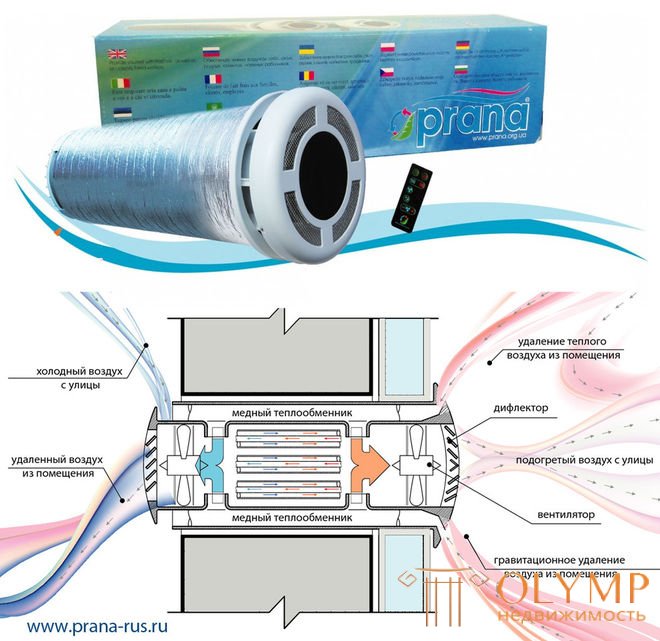
But in the heat exchanger Prana-200G, the heat exchanger consists of several “pipe in pipe” elements made of copper: through the thin pipes inside each such element, air flows out of the room, and through the thick ones it flows. However, due to such a complex structure, the diameter of the device body grows to 200 mm, but the maximum air intake of the device is 135 cubic meters / h, and the maximum exhaust volume is 125 cubic meters / h. And this is with a recovery efficiency of 74%!
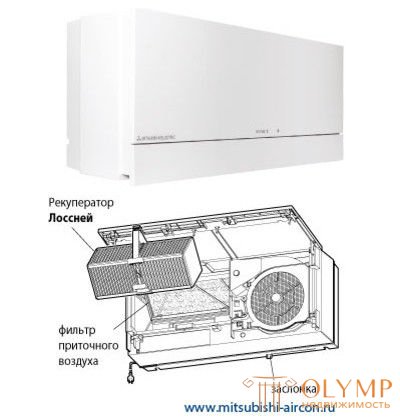
Mitsubishi Electric has found its original path. Its air handling units with heat recovery looks very similar to the internal unit of the split system. The Lossnay VL-100EU5-E device simultaneously operates on the inflow and the exhaust: air is supplied and discharged through two holes with a diameter of 80-85 mm drilled in the wall. Its consumption can be adjusted in steps (65 or 105 cubic meters / h). In the summer, the system can not only cool, but also dry the supply air, and in the winter - to heat and moisten it. This is possible thanks to the patented ultra-thin rice paper recuperator impregnated with a special compound.
This unusual heat exchanger also has a selective gas permeability. For example, it freely passes water vapor, but detains such harmful gases as ammonia and carbon dioxide. The device itself is additionally equipped with two air filters and a noise reduction system in the fresh air channel.
The LGH-40ES installation (semi-industrial) of the same brand differs from the previous one in higher productivity (air consumption 250-400 cubic meters / h) and is installed horizontally under the ceiling itself (900 mm wide, 693 mm deep, 55 mm high) .
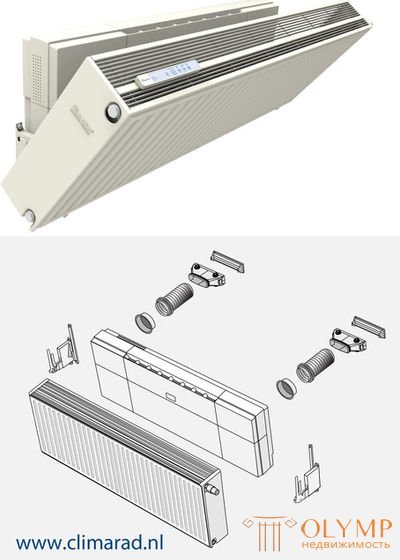
Even more original, in our opinion, the solution was found by the company ClimaRad (Netherlands), creating an innovative ventilation system ClimaRad 2.0, not only the ventilating room, but also heating it. The whole trick is that the structure of the ventilation module includes a filter, a heat exchanger, as well as intake and exhaust fans, due to which from 30 to 125 cubic meters / h of fresh air is fed into the room. The device is placed behind the swinging radiator of water heating - this arrangement saves space and does not spoil the interior. ClimaRad is available in both horizontal and vertical versions. True, the price of this "exclusive" significantly exceeds the range indicated by us.
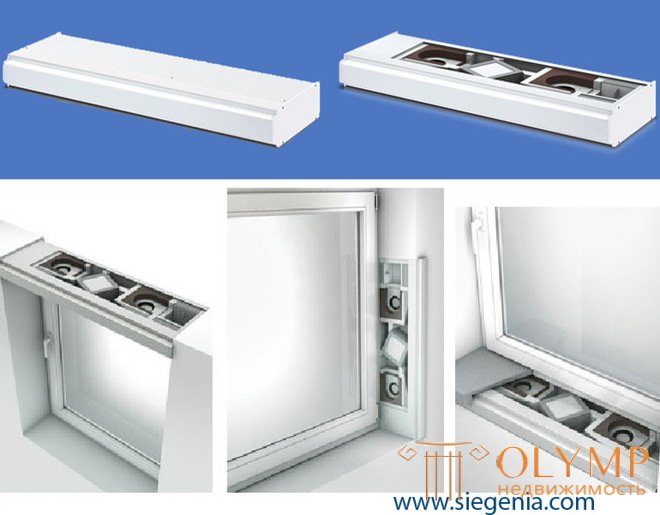
The original installation site was found for its AEROMAT VT ventilator equipped with a recuperator and SIEGENIA GRUPPE (Germany). Small dimensions (length 1000 mm, installation depth 320 mm), and most importantly - small thickness (only 100 mm) allow the device to be mounted hidden under the frame and sill, but it can be installed above the window frame or to the side of it - this is why to window ventilators. At the same time, the device has a high throughput (15-60 cubic meters / h), consumes a little energy and allows to continuously adjust the volume of air supplied to the room. The efficiency of heat recovery can reach up to 62% without the formation of condensate.
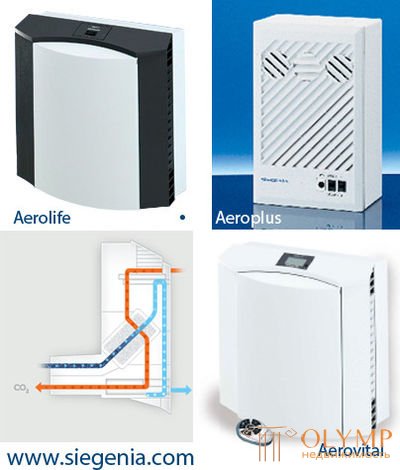
It is impossible not to mention three more models of heat recovery ventilators manufactured by the same company. These are wall-mounted appliances such as Aerolife, Aeroplus and Aerovital.
Aerolife is equipped with a filter that captures even pollen, and is very quiet in operation, making it suitable for bedrooms and nurseries. At the same time, the device is equipped with a three-stage capacity adjustment, a bright LCD display and temperature and humidity sensors in the room. Heat recovery efficiency - 66%.
Aerovital is equipped with a filter that protects against pollen, and has ten levels of regulation, and control it with a remote control. The recovery efficiency of this device is 70%.
Aeroplus was created specifically to combat excessive humidity in the premises. The smart device not only filters the incoming air and heats it, but also doses its inflow according to the given humidity and temperature parameters in the room. This not only creates a healthy microclimate, but also contributes to the safety of the home. Moisture that condenses when the heat exchanger is working is discharged into the air intake pipe. The ventilator is powered by 12V and operates in energy saving mode. Recovery efficiency - up to 50%.

Of course, SIEGENIA has competitors. For example, VENTS releases the Micra 60 air handling unit, which also supplies and discharges air into various openings. After filtration, cold air enters an aluminum plate countercurrent heat exchanger located inside the device housing, where it meets with air removed from the room, and, taking its heat, enters inside. In this case, the recovery efficiency reaches 78%. The device provides full ventilation of the room with an area of up to 24 sq.m and ample air exchange for two people.

And the last series of devices you need to talk about. For those who have a house heated by a wood boiler or a fireplace (or even just a house has a fireplace), the ECO-FRESH series ventilators manufactured by the Bulgarian company MMotors JSC may be useful. These are four ventilators with a heat exchanger - models 01, 03, 05 and 07 (in this order they are shown in the photo), equipped with a CO (carbon monoxide) sensor and a hygrometer. What are these devices useful for?
When there is not enough fresh air flowing into the room where a wood-burning boiler or fireplace is installed (there should be at least 4 cubic meters / hour for every kilowatt of heat output of the device, and using an open fireplace even more), probably incomplete combustion to form CO. The sensor, detecting the presence of this toxic substance in the air without color and odor, turns on the intake fan in AirFlow mode. Well, the built-in hydrostat keeps the air humidity at a given level. In addition, the devices are equipped with an ionizer. Built-in two-speed exhaust fan allows you to adjust the amount of outgoing air flow in the range from 30 to 100 cubic meters / h.
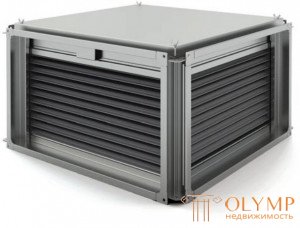
When using plate heat exchangers Korf PR, energy costs are reduced due to the use of exhaust air heat (the heat recovery efficiency reaches 70%).
The heat transfer structure is formed by specially profiled aluminum plates with a thickness of 0.2 mm. The design provides for the collection and discharge of condensate (removable panel in the form of a pallet and fitting).
The plate heat exchanger body is made of galvanized steel and equipped with flanges. Heat exchanger suspension.
The calculation of the efficiency of the plate heat exchanger:

T1 - outdoor temperature
T2 - exhaust air temperature
T3 - exhaust air temperature
T4 - supply air temperature
Что бы оставить комментарий войдите
Комментарии (0)